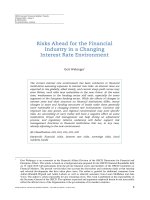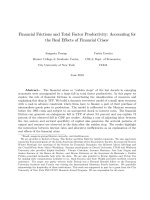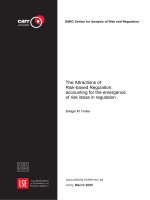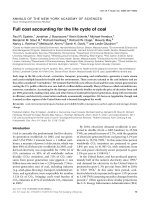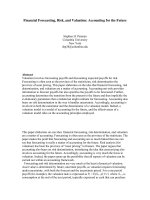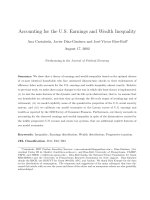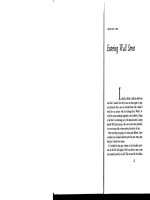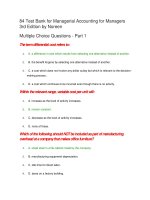Lecture Managerial Accounting for the hospitality industry: Chapter 2 - Dopson, Hayes
Bạn đang xem bản rút gọn của tài liệu. Xem và tải ngay bản đầy đủ của tài liệu tại đây (447.71 KB, 45 trang )
Chapter 2
Accounting
Fundamentals Review
© 2009 John Wiley & Sons
Hoboken, NJ 07030
1
Managerial Accounting for the Hospitality Industry
Dopson & Hayes
Chapter Outline
Bookkeeping and Accounting
The Accounting Formula
Recording Changes to the Accounting Formula
Generally Accepted Accounting Principles
The Hospitality Business Cycle
© 2009 John Wiley & Sons
Hoboken, NJ 07030
2
Managerial Accounting for the Hospitality Industry
Dopson & Hayes
Learning Outcomes
Explain the basic accounting formula and how it is
modified using debits and credits.
Identify generally accepted accounting principles and
state why they exist.
Describe how accounting is used in the hospitality
business cycle.
© 2009 John Wiley & Sons
Hoboken, NJ 07030
3
Managerial Accounting for the Hospitality Industry
Dopson & Hayes
Bookkeeping and Accounting
In the hospitality industry, bookkeepers of all types
perform the critically important task of initially recording
financial transactions in a business
Servers, bartenders, kitchen staff of a restaurant
Front desk, controller, and other staff of a hotel
As a hospitality manager it is important that you ensure
accurate and timely bookkeeping and accounting
methods to produce the financial data you must analyze
to make decisions.
© 2009 John Wiley & Sons
Hoboken, NJ 07030
4
Managerial Accounting for the Hospitality Industry
Dopson & Hayes
The Accounting Formula
Assets are those items owned by the business
Liabilities are the amounts the business owes to others
Owners’ equity is the residual claims owners have on
their assets, or the amount left over in a business after
subtracting its liabilities from its assets.
The Accounting Formula states that, for every business:
Assets = Liabilities + Owners’ Equity
© 2009 John Wiley & Sons
Hoboken, NJ 07030
5
Managerial Accounting for the Hospitality Industry
Dopson & Hayes
The Accounting Formula
Owners’ equity accounts include two major subcategories called permanent accounts and temporary
accounts.
Permanent owners’ equity accounts include:
Stock (or owners’ investment) and
Retained earnings (accumulated account of profits
over the life of the business that have not been
distributed as dividends)
Dividends are money paid out of net income to
stockholders as a return on their investment in the
company’s stocks.
© 2009 John Wiley & Sons
Hoboken, NJ 07030
6
Managerial Accounting for the Hospitality Industry
Dopson & Hayes
The Accounting Formula
Temporary owners’ equity accounts include:
Revenue (increase owners’ equity) and
Expense accounts (decrease owners’ equity)
At the end of the accounting period, the temporary
accounts are closed out (their balances reduced to
zero).
The resulting current period's net profit or loss is used to
update the balance of the permanent owners’ equity
account in retained earnings.
© 2009 John Wiley & Sons
Hoboken, NJ 07030
7
Managerial Accounting for the Hospitality Industry
Dopson & Hayes
The Accounting Formula
The permanent and temporary owners’ equity accounts
are shown in the following modification of The
Accounting Formula:
Assets =
© 2009 John Wiley & Sons
Hoboken, NJ 07030
Liabilities
+ Permanent Owners’ Equity (Stocks + Retained Earnings)
+ Temporary Owners’ Equity (Revenue - Expenses)
8
Managerial Accounting for the Hospitality Industry
Dopson & Hayes
The Accounting Formula
The balance sheet and the income statement are
developed from The Accounting Formula.
The balance sheet is an accounting summary that
closely examines the financial condition of a business,
by reporting the value of a company’s total assets,
liabilities, and owners’ equity on a specified date.
The income statement reports in detail and for a very
specific time period, a business’s revenue from all its
revenue producing sources, the expenses required to
generate those revenues, and the resulting profits or
losses (net income).
© 2009 John Wiley & Sons
Hoboken, NJ 07030
9
Managerial Accounting for the Hospitality Industry
Dopson & Hayes
Recording Changes to the
Accounting Formula
Additions to or subtractions from one of the sides of the
Accounting Formula must be counterbalanced with an
equal addition to, or subtraction from, the other side of
the equation.
It is also possible to make changes (equal additions and
subtractions) to only one side of the Accounting
Formula.
© 2009 John Wiley & Sons
Hoboken, NJ 07030
10
Managerial Accounting for the Hospitality Industry
Dopson & Hayes
Double-Entry Accounting
Double-entry accounting (sometimes called doubleentry bookkeeping) requires that the person recording a
financial transaction make at least two separate
accounting entries (changes to its accounts) every time
a financial transaction modifies The Accounting Formula
of a business.
A double-entry system is used to catch recording errors
and to accurately track the various streams of money in
and out of businesses.
© 2009 John Wiley & Sons
Hoboken, NJ 07030
11
Managerial Accounting for the Hospitality Industry
Dopson & Hayes
Journal and General Ledger
A journal is the written record of a specific business’s
financial transactions.
A journal entry is made to a specific account when
changes to The Accounting Formula are recorded.
The general ledger consists of up-to-date balances of
all a business’s individual asset, liability, and owners’
equity (as well as revenue and expense) accounts.
© 2009 John Wiley & Sons
Hoboken, NJ 07030
12
Managerial Accounting for the Hospitality Industry
Dopson & Hayes
Figure 2.4 Foundational Accounting Concepts
Important concepts for an accountant to remember about maintaining a
business’s general ledger are:
1. The Accounting Formula, which is the summary of a business’s asset, liability
and owners’ equity accounts, must stay in balance.
2. The Accounting Formula is affected every time a business makes a financial
transaction.
3. Each financial transaction is to be recorded two times in a double entry
accounting system; thus minimizing the chance for making an error in
recording.
4. The original records of a business’s financial transactions are maintained in
its journal, and each financial transaction recorded is called a journal entry.
5. The current balances of each of a business’s individual asset, liability and
owners’ equity accounts are totaled and maintained in its general ledger.
© 2009 John Wiley & Sons
Hoboken, NJ 07030
13
Managerial Accounting for the Hospitality Industry
Dopson & Hayes
Credits and Debits
The asset, liability, and owners’ equity portions of the
Accounting Formula can be broken down into smaller
units called accounts.
Because of their shape, accountants often call these
individual accounts “T” accounts.
Figure 2.5 T Account
Name of Account
Left (Debit)
© 2009 John Wiley & Sons
Hoboken, NJ 07030
14
Right (Credit)
Managerial Accounting for the Hospitality Industry
Dopson & Hayes
Figure 2.6 Journal Entry Principles
1. To make a complete journal entry, at least two different accounts must be
used to record the event (when using double entry accounting).
2. Each journal entry must consist of at least one debit entry and one credit
entry.
3. The total of all debit entries in a transaction must always equal the total of all
credit entries.
4. When the above principles are followed, The Accounting Formula will always
be in balance. If the formula is not in balance, an error has been made in
recording one or more journal entries and must be corrected.*
*Sometimes those who are new to double entry accounting can make mistakes because it is easy
to forget that a “debit” is made on the left side of a T account and a “credit” is made on the right
side. It is easy to remember the correct way to make the entries if you just remember that the
word “debit” has one less letter in it than does the word “credit”. And, it is also true that the word
“left” has one less letter than the word “right”! Thus,
Debit = Left
Credit = Right
© 2009 John Wiley & Sons
Hoboken, NJ 07030
15
Managerial Accounting for the Hospitality Industry
Dopson & Hayes
Credits and Debits
Common accounts are:
Asset Accounts
Liability Accounts
Owners’ Equity Accounts
Current Assets
Cash
Accounts receivable
Inventories
Current Liabilities
Accounts payable
Taxes due and payable
Notes payable
Permanent Accounts
Stock (or owner’s investment)
Retained earnings
Fixed Assets
Furniture, Fixtures, and Equipment
Buildings
Land
Accumulated Depreciation
(contra asset account)
Long-term debts payable
Temporary Accounts
Revenue accounts
Expense accounts
© 2009 John Wiley & Sons
Hoboken, NJ 07030
16
Managerial Accounting for the Hospitality Industry
Dopson & Hayes
Credits and Debits
The difference between a T account’s total debits and
total credits is called the account balance.
Remembering the impact of debits and credits on the
components of The Accounting Formula can be difficult.
Dr. Don St. Hilaire and his students at California State
Polytechnic University, Pomona devised a “trick” that
will help make this easier.
Imagine that your left hand represents debits and your
right hand represents credits.
© 2009 John Wiley & Sons
Hoboken, NJ 07030
17
Managerial Accounting for the Hospitality Industry
Dopson & Hayes
Figure 2.9 Left Hand (Debits) and Right Hand (Credits)
Debits
© 2009 John Wiley & Sons
Hoboken, NJ 07030
Credits
Thumb
Assets (A)
Pointer finger
Liabilities (L)
Middle finger
Owners’ Equity (OE)
Ring finger
Revenues (R)
Pinky finger
Expenses (E)
18
Managerial Accounting for the Hospitality Industry
Dopson & Hayes
Credits and Debits
Increases ↑ and decreases ↓ in accounts can be
summarized as follows:
Figure 2.10 Increases and Decreases in Accounts
Debits
Credits
↑ Assets
↓ Assets
↓ Liabilities, ↓ Owners’ Equity, ↓ Revenues
↑ Liabilities, ↑ Owners’ Equity, ↑ Revenues
↑ Expenses
↓ Expenses
© 2009 John Wiley & Sons
Hoboken, NJ 07030
19
Managerial Accounting for the Hospitality Industry
Dopson & Hayes
Figure 2.11 Using Your Hands to Remember Increases and Decreases of
Accounts
Debits
Left Hand – Debits
Credits
Right Hand - Credits
thumb up =
↑in assets
thumb down =
↓in assets
pointer finger down =
↓in liabilities
pointer finger up =
↑in liabilities
middle finger down =
↓in owners’ equity
middle finger up =
↑in owners’ equity
ring finger down =
↓in revenue
ring finger up =
↑in revenue
pinky finger up =
↑in expenses
pinky finger down =
↓in expenses
© 2009 John Wiley & Sons
Hoboken, NJ 07030
20
Managerial Accounting for the Hospitality Industry
Dopson & Hayes
Credits and Debits
To see how the use of debits, credits, and double-entry
accounting affect individual T accounts and thus The
Accounting Formula, consider the Stagecoach
restaurant.
It has just begun its operation with a $1,000,000 check
from its owner.
© 2009 John Wiley & Sons
Hoboken, NJ 07030
21
Managerial Accounting for the Hospitality Industry
Dopson & Hayes
g o fig u re!
1. A $1,000,000 debit to “Cash” (↑ Asset)
2. A $1,000,000 credit of the owner’s investment (↑ Owners’ Equity)
The resulting T accounts are as follows:
Cash
1,000,000
Owners’ Equity
1,000,000
© 2009 John Wiley & Sons
Hoboken, NJ 07030
22
Managerial Accounting for the Hospitality Industry
Dopson & Hayes
( g o fig ure! continued)
Upon completion of these initial journal entries, the Stagecoach’s Accounting
Formula would read as follows:
Assets
=
Liabilities
+
Owners’ Equity
+
$1,000,000
or
$1,000,000
© 2009 John Wiley & Sons
Hoboken, NJ 07030
=
$0
23
Managerial Accounting for the Hospitality Industry
Dopson & Hayes
Credits and Debits
Now assume that the restaurant’s owner established a
T account titled “Uniforms”, as well as the “Cash”
account previously established.
The manager then purchases, with cash, $1000 worth
of uniforms for the future dining room staff. This
decreases the amount of money in the “Cash” asset
account and increases the value of the “Uniforms” asset
account.
© 2009 John Wiley & Sons
Hoboken, NJ 07030
24
Managerial Accounting for the Hospitality Industry
Dopson & Hayes
g o fig u re!
1. A $1,000 credit to “Cash” (↓ Asset)
2. A $1,000 debit to “Uniforms” (↑ Asset)
The resulting T accounts are as follows:
Cash
$1,000
Uniforms
$1,000
© 2009 John Wiley & Sons
Hoboken, NJ 07030
25
Managerial Accounting for the Hospitality Industry
Dopson & Hayes
